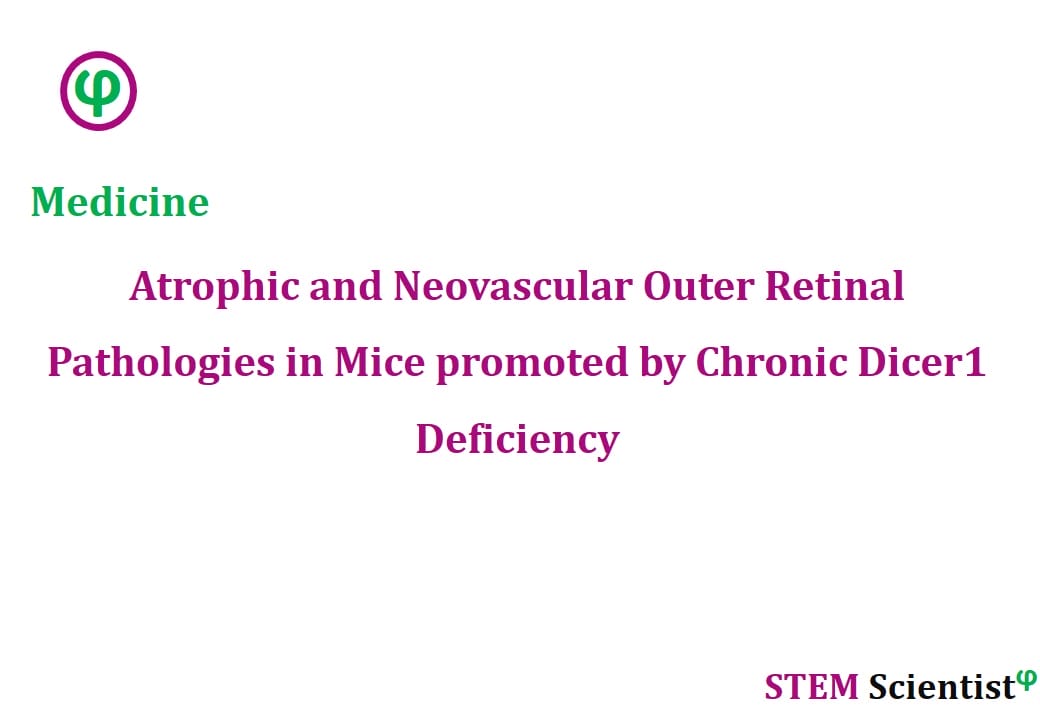
The following study was conducted by Scientists from University of Kentucky, Lexington; Loma Linda University, Loma Linda; University of Virginia School of Medicine, Charlottesville; The Jackson Laboratory, Bar Harbor; University of Virginia School of Medicine, Charlottesville, USA; Universidade Federal de São Paulo, São Paulo, Brazil; Aravind Medical Research Foundation, Madurai, Tamil Nadu, India; University of Tsukuba, Ibaraki, Japan; Laboratoire d’ImmunoRhumatologie Moléculaire, INSERM; LabEx Transplantex, Fédération de Médecine Translationnelle de Strasbourg, Université de Strasbourg, France; Fédération Hospitalo-Universitaire OMICARE, Université de Strasbourg, France; Gunma University, Maebashi, Japan. Study is published in Proceedings of the National Academy of Sciences Journal as detailed below.
Proceedings of the National Academy of Sciences (2020); 117(5): 2579-2587
Chronic Dicer1 Deficiency Promotes Atrophic and Neovascular Outer Retinal Pathologies in Mice
Significance
DICER1 processes micro-RNAs into their bioactive forms and metabolizes RNAs from short interspersed nuclear element genetic repeats, principally Alu RNAs in humans. DICER1 deficiency is implicated in retinal pigmented epithelium (RPE) degeneration in atrophic age-related macular degeneration (AMD). Here, we report that three independent mouse models of DICER1 deficiency develop RPE degeneration and aberrant choroidal and retinal neovascularization (CRNV), both hallmarks of advanced AMD. These pathologies were dependent on inflammatory caspases 1 and 11 and the signaling adaptor MyD88. We observed reduced DICER1 abundance in a separate model of spontaneous CRNV and developed an adenoassociated vector-mediated DICER1 delivery construct, which reduced the severity of established spontaneous CRNV. Thus, persistent deficiency in DICER1 results in RPE degeneration and CRNV.
Abstract
Degeneration of the retinal pigmented epithelium (RPE) and aberrant blood vessel growth in the eye are advanced-stage processes in blinding diseases such as age-related macular degeneration (AMD), which affect hundreds of millions of people worldwide. Loss of the RNase DICER1, an essential factor in micro-RNA biogenesis, is implicated in RPE atrophy. However, the functional implications of DICER1 loss in choroidal and retinal neovascularization are unknown. Here, we report that two independent hypomorphic mouse strains, as well as a separate model of postnatal RPE-specific DICER1 ablation, all presented with spontaneous RPE degeneration and choroidal and retinal neovascularization. DICER1 hypomorphic mice lacking critical inflammasome components or the innate immune adaptor MyD88 developed less severe RPE atrophy and pathological neovascularization. DICER1 abundance was also reduced in retinas of the JR5558 mouse model of spontaneous choroidal neovascularization. Finally, adenoassociated vector-mediated gene delivery of a truncated DICER1 variant (OptiDicer) reduced spontaneous choroidal neovascularization in JR5558 mice. Collectively, these findings significantly expand the repertoire of DICER1 in preserving retinal homeostasis by preventing both RPE degeneration and pathological neovascularization.
Source:
Proceedings of the National Academy of Sciences
URL: https://www.pnas.org/content/117/5/2579
Citation:
Wright, C. B., H. Uehara, et al. (2020). “Chronic Dicer1 deficiency promotes atrophic and neovascular outer retinal pathologies in mice.” Proceedings of the National Academy of Sciences 117(5): 2579-2587.


